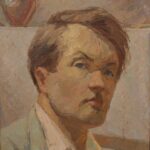
Kosciuška Vaclovas
(1911-1984)
Vaclovas Kosciuska was born and lived in an era in which the idealistic exaltation of the concepts of “nation” and “fatherland” constantly struggled with reality, which trampled, devastated, and destroyed nations and their homelands. Despite all the trials of fate, the most beautiful city in the world for Kosciuska remained Vilnius, and the most dear and interesting country was Lithuania. Concern for the survival of Lithuania and the preservation and development of Lithuanian identity firmly linked Kosciuska with the culture formed by the romantic worldview and the tradition of realistic expression, which allowed him to convey allegorical images and that reality, which had symbolic meaning, power, and value for the artist’s compatriots, in a form understandable to everyone. The circle of Kosciuska’s admirers was and remains considerable, because the artist painted what was and is beautiful to the eyes that loved Lithuania. The motifs of his landscapes are sun-drenched fields, lush summer meadow grass, clean rivers and streams, banks overgrown with trees, wooden village huts and cozy courtyards of Vilnius Žvėrynas, fluffy white clouds flying across the blue sky and the flickering of colorful autumn leaves, winding streets of Vilnius Old Town and neatly lined up cornfields in cleanly cleared fields. The bright colors of Kosciuszko’s still lifes were captivating in the grayness of the Soviet era, and his attempts to open a window into the world of legends were attractive and somewhat eccentric – with mermaids, kips, fogs or clouds taking on anthropomorphic forms, and angelic girls.
Kosciuszko has painted more than one painting of museum value. However, the totality of this artist’s work cannot be measured by painting alone. Kosciuszko had no shortage of mastery and skills, which he successfully applied in the most diverse areas of artistic creation. He was a true universalist: he worked in the fields of painting, graphics, print design, applied arts, and medal making; his name is associated with the history of modern Lithuanian photography. Kosciuska also distinguished himself in the field of church art, which the great talents of 20th-century Lithuanian art avoided.
According to his old friend Boleslovas Motuza (see the memoirs printed in the catalog), Kosciuska did not create masterpieces. However, he left behind the legend of a patriotic Lithuanian from Vilnius, a free representative of bohemia, and works that are becoming an increasingly important part of the artistic heritage of mid-20th-century Lithuania, representing its diversity and little-known facets.


